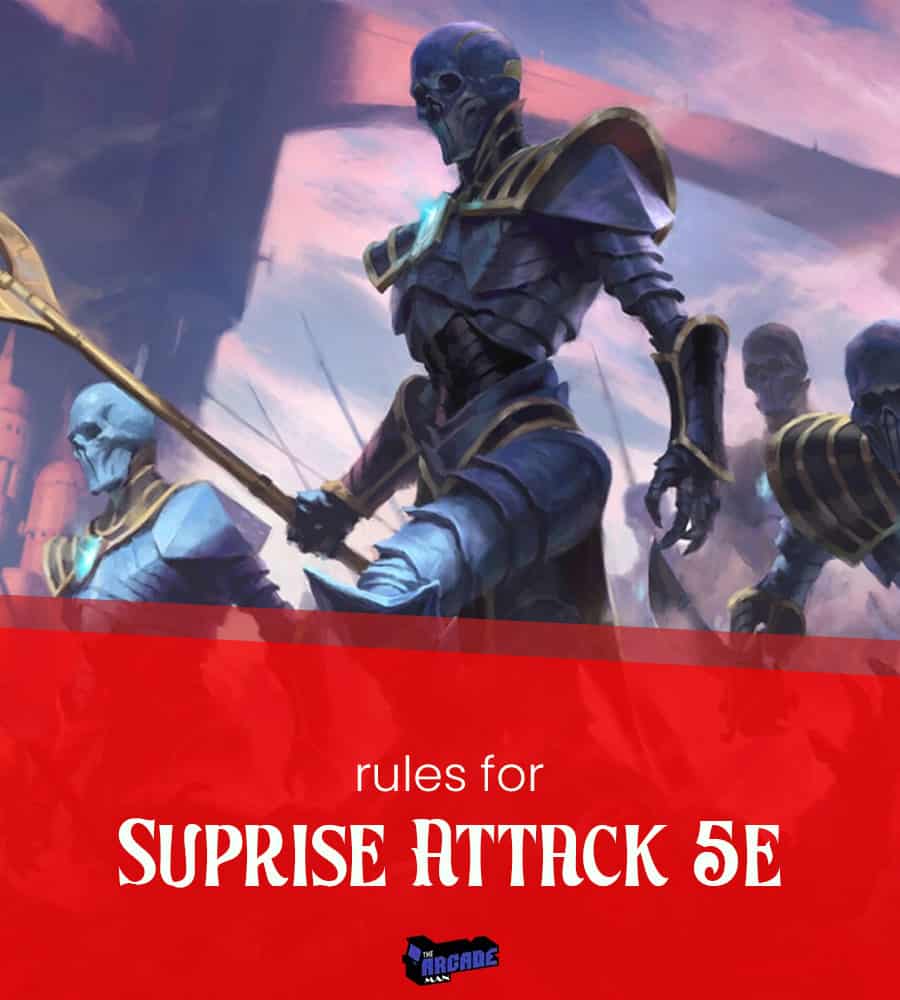How Does Surprise Attack 5e Work?

Surprise attacks can add a thrilling element to combat encounters in Dungeons and Dragons 5th edition (D&D 5e). A well-executed surprise attack can give a strategic advantage to the attacking party and potentially even turn the tide of a battle.
However, surprise attacks can also be a source of confusion and disagreement among players and DMs. Understanding how surprise attacks work is crucial for players and DMs alike, as it can significantly impact the outcome of a combat encounter.
This article will delve deeper into the mechanics of surprise attacks in D&D 5e and explore tips and strategies for using this powerful tactic effectively.
What is a Surprise Round or Surprise Attack in Dnd 5e?
In D&D 5e, a surprise round, also known as a surprise attack, is a specific type of combat round that occurs when one or more creatures are unaware of the impending attack. When combat begins, the DM determines which creatures, if any, are surprised.
If a creature is surprised, it cannot take actions or reactions during the first round of combat. This means they cannot move, attack, cast spells, or use any special abilities until their turn in the second round of combat.
The attacking party has the advantage of being able to act before the surprised creatures, potentially allowing them to inflict significant damage or take other advantageous actions.
It’s important to note that not all combats will have a surprise round, and the DM is responsible for determining if a combat encounter warrants a surprise round. The DM will use the Surprise rule to determine which creatures are surprised, taking into account factors such as the creature’s perception and alertness.
Rules For Surprise Attack 5e

To determine which creatures are surprised, the DM will use a combination of the creatures’ perception and alertness. For example, if the attacking party is trying to sneak up on a group of goblins, the DM might ask the attacking party to make a group Dexterity (Stealth) check.
The DM will then compare this to the goblins’ passive Wisdom (Perception) scores. If the attacking party succeeds in their check and the goblins fail on their perception check, the goblins are considered surprised.
When surprise adversaries, hiding is essential. If you wish to surprise somebody, you must remain undetected according to the specified regulations. The basic idea behind hiding is to make Stealth rolls that are disputed by Perception tests made by anyone who would be able to find you. A monster that sees or hears you cannot be avoided. It’s hard to conceal from a creature after the fighting starts since it will be on guard for danger.
Normally, leaving a hiding spot to attack will betray your location, however, DMs sometimes are. Passive Perception allows creatures to detect hazards even when they are not actively seeking them. Passive Perception will receive a +5 boost if you succeed on Perception checks.
While engaged in battle, you cannot surprise a creature and force it to lose a turn, but you can conceal from them to strike covertly. Obscuring elements like fog or dense vegetation can reduce visibility. Hearing loss may result from the Silence spell. Characters may become blind or deaf.
If eyesight is restricted, it will be more challenging to locate a creature, object, or another notable trait that is not immediately apparent. The PHB’s chapter eight goes into further detail on this.
Stealth is a subheading under “Activity While Traveling” in chapter eight of the PHB (p. 182). If you’re not in a hurry, it states you can move slowly to sneak up on or go around groups of creatures you come across while traveling.
The marching orders for adventuring groups are outlined in the journeying section. Party members in the front of the line in the marching order have an advantage in recognizing threats. DMs may select that only characters in the party’s rear ranks will be aware of foes following and shadowing them.
In either scenario, the PHB’s preferred skill check for avoiding surprises while traveling is passive Wisdom (Perception). If the party is moving quickly, Passive Perception is reduced by five.
The PHB’s chapter nine discusses surprise rules in more detail as well as fighting rules. On page 189, it is said that surprise happens when one or both factions are being covert and unsuspected. It’s important to remember that if both parties are trying stealth and some of the individual Passive Perceptions are defeated, both sides might potentially have people who are shocked when the fighting begins.
The first task of the DM, when the battle starts, is to identify which monsters are startled, according to page 189. The DM can do this by contrasting any aggressor’s Stealth dice with the approach’s Passive Perceptions. I advise DMs to have all characters’ passive perceptions written down somewhere where they can easily access them because this process of assessing surprise might slow down the game’s pace.
Conditions Where Surprise Works
1. Monsters Suprising Characters

But what if we flip sides? If the monsters are attempting to ambush the characters, how does it work? Say the gnolls are aware that the PCs are approaching and are trying to hide. Consider that there are sixteen gnolls. We won’t be rolling 16 stealth checks.
Things make it reasonable that some gnoll is going to mess it up. Additionally, we won’t make a group stealth check for 16 gnolls. We can substitute the gnolls’ inert Stealth. Their passive Dexterity (Stealth) rating is 11.
Not very good. If any of the characters have a passive Perception score of 11 or above, the characters will notice them. Each character does, however, have a unique passive perception.
This is rather severe. A player hates to lose an action. Even if it makes logical, we should only do this when it truly highlights a crucial part of the game.
If you don’t like the notion of a passive Dexterity (Stealth) check, you might instead have the entire party roll a Dexterity (Stealth) check at a disadvantage and apply it against the characters’ passive Perceptions to see who gets startled.
2. Characters Surprising Monster
Let’s imagine the adventurers come into a circumstance where they can attempt to surprise some gnolls in some dark caverns. The characters are aware that the gnolls are leaving the cave. The characters spend some time getting ready.
Each person makes a stealth check. While Darkshadow the rogue rolls a 17, Stompy the paladin predictably rolls a 6. The gnolls’ view of 10 is passive. Time pauses as they turn the corner and the rogue draws their crossbow, at which point we roll for initiative.
There is no surprise round, keep that in mind. Prior to the initiative being rolled, the shot is not fired and gets resolved. Time halts and we roll for initiative the moment any creature starts an unfriendly action against another creature.
The paladin, Stompy, rolls a 7, the gnolls roll a 12, and the rogue rolls a 19. The gnolls hear Stompy and clearly do not see Darkshadow when we compare the initial stealth checks to their passive Perceptions.
Stompy doesn’t surprise them, therefore they aren’t surprised. Darkshadow still has the upper hand because the gnolls completely missed them, but when it’s their turn, they can move and take action. They are not shocked.
This implies that the gang will almost always fall short in their attempts to catch their adversaries off guard because Stompy invariably drags them down. Instead, if the circumstances call for it, we DMs can decide that the characters can make a collective stealth check rather than individual ones.
See “Group Checks” in Player’s Handbook chapter 7 for further information. Even while Stompy is still slowing the gang down, Darkshadow’s high stealth check more than makes up for it. The gnolls are startled by the whole party if the bulk of the group achieves a stealth check greater than the passive Perception of the gnolls.
We probably want to make sure that it takes effort to put it up because this interpretation strongly benefits the characters. The characters should have sufficient time to coordinate their hiding strategies and a good grasp of the location and goals of their adversaries. But under the correct conditions, a group stealth check makes sense.
The Advantage to Hit a Surprised Creature
New DMs frequently ask me, “Does surprise offer an advantage in 5e?,” which I’ve seen a lot. The response is no… and occasionally, yeah. If and when this is the case, the fact that you are an “unseen attacker” gives you an edge over your target even if they are “surprised.” The Player’s Handbook reads as follows on page 195:
“When a creature can’t see you, you have advantage on attack rolls against it. If you are hidden–both unseen and unheard–when you make an attack, you give away your location when the attack hits or misses.”
According to this remark, you can only ever have the upper hand during the opening attack of a battle since after that, it is thought that you have revealed your position (and would need to successfully take the Hide action, before being counted as an unseen attacker once more).
There is some debate about whether a melee attacker may also gain from going unnoticed while attacking a shocked opponent, as opposed to an archer concealed in the woods. It might be challenging to determine if a monster can sneak up on its target in the 5th edition because there are no strict facing requirements.
Conclusion
As you can see, surprise is an accidental status that is influenced by a creature’s environment rather than being a round or condition. Although situations that cause a creature to be surprised frequently include concealed attackers, who normally have an advantage on their attacks, assaults against a shocked creature are not always done with an advantage.
Allowing sneaky players to begin combat will prevent them from possibly wasting their class abilities. This article should have helped you comprehend the purpose of surprise in D&D. Take it and add it to your toolkit for telling thrilling adventures and high-action tales to your loved ones.






